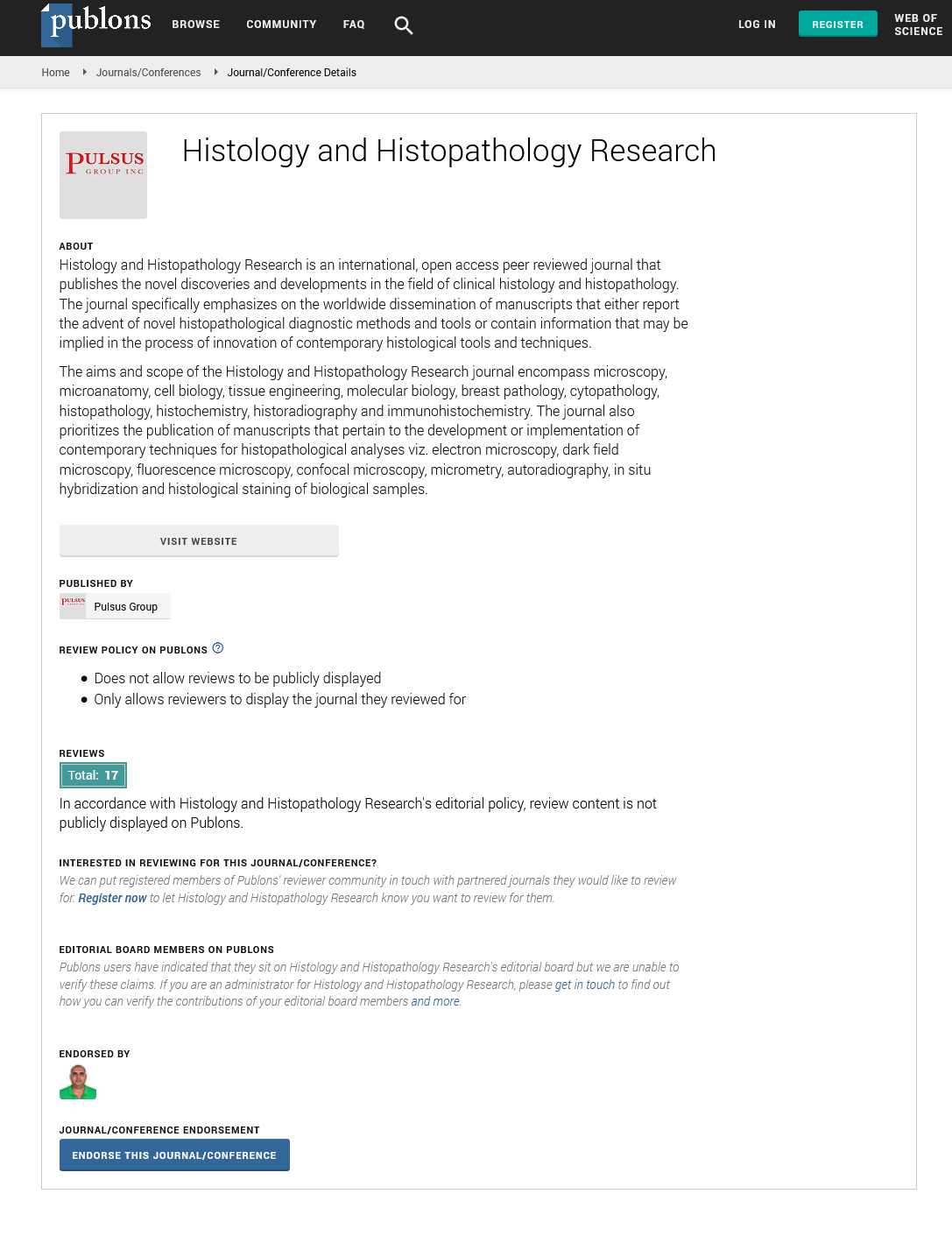A note on signs and symptoms of autoimmune disorder: Rheumatoid arthritis
Received: 16-Sep-2021 Accepted Date: Sep 30, 2021; Published: 07-Oct-2021
Citation: Fernandez M. A note on signs and symptoms of autoimmune disorder: Rheumatoid arthritis. J Histol Histopathol 2021;5(3):1-2.
This open-access article is distributed under the terms of the Creative Commons Attribution Non-Commercial License (CC BY-NC) (http://creativecommons.org/licenses/by-nc/4.0/), which permits reuse, distribution and reproduction of the article, provided that the original work is properly cited and the reuse is restricted to noncommercial purposes. For commercial reuse, contact reprints@pulsus.com
Description
Rheumatoid Arthritis (RA) is an autoimmune disorders the joints throughout period. Warm, swelling, and painful joints are symptoms. Sleeping promotes pain and stiffness may worsen. The wrist and hands are the most usually impacted joints, with the same joints on both sides of the body. Other parts of the body, including as the skin, eyes, lungs, heart, nerves, and blood, may be affected by the disease. Low red blood cell levels, inflammation around the lungs, and inflammation around the heart are all potential consequences. There may also be a fever and a decreased energy. Symptoms usually occur gradually over weeks or even months [1-4].
Rheumatoid arthritis is mainly caused by a combination of genetics and the environment, while the specific condition affects. The immune system of the body attacks the joints as the underlying mechanism. The joint capsule expands and becomes painful as a result of this. It also affects the bone and cartilage beneath the epidermis. The most of diagnosis are made based on a person's indications and symptoms. X-rays and laboratory tests can help confirm a diagnosis or rule out other diseases that have similar symptoms. Systemic lupus erythematous, psoriatic arthritis, and fibromyalgia are among the disorders that can present similarly.
Treatment attempts to reduce pain, reduce inflammation, and improve a person's overall functioning. Appropriate rest and exercise, the use of splints and braces, and the use of assistive technologies may all help. Pain relievers, steroids, and steroidal anti-inflammatory drugs (NSAIDs) are widely used to alleviate symptoms. To try to slow the progression of disease, Disease-Modifying Antirheumatic Medicines (DMARDs) including hydroxychloroquine and methotrexate may be used. When other treatments fail to control the condition, biological DMARDs may be used. They may, however, have a higher rate of side effects. In some circumstances, surgery to repair, replace, or fuse joints may be useful.
As of 2015, RA affects approximately 24.5 million people. In the developed world, this occurs between 0.5 and 1% of adults, with 5 to 50 people per 100,000 developing the disease each year. The onset is most common age, and women are 2.5 times more likely than males to be affected. The name rheumatoid arthritis comes from a Greek word rheumatoid, which means "watery and inflamed joints."
The synovial membrane is damaged in arthritis of the joints. Swollen, sensitive, and heated joints become hard, inhibiting movement. Multiple joints are impacted over time (polyarthritis). The tiny joints of the hands, legs, and cervical spine are the most typically affected, but larger joints such as the shoulder and knee can also be affected. The specialised mesenchymal cells located in the synovial membrane, Fibroblast-Like Synoviocytes (FLS), play an active and important role in these rheumatic joint pathological conditions.
Swollen, warm, painful, and stiff joints are common symptoms of RA, particularly initially thing every morning sometimes after a period of silence. Early in the morning stiffness is a common symptom of the disease, and it usually lasts for more than an hour. In the early stages of the disease, gentle motions may help to reduce discomfort. These symptoms separate rheumatoid arthritis from non-inflammatory joint issues like osteoarthritis. Inflammation and early morning stiffness are less common in arthritis caused by non-inflammatory sources.
The pain associated with RA is nociceptive instead of neuropathic, as it is produced at the site of inflammation. Although the joints are frequently affected in a regular pattern, it is not always the case, and the initial presentation may be asymmetrical.
The inflammatory activity of the illness continues, producing tendon tethering and erosion and damage of the joint surface, reducing strength and flexibility and leading to deformity. Depending on which joints are most implicated, the fingers can also have virtually any abnormality.
Ulnar deviation, boutonniere deformity (also "buttonhole deformity," flexion of the proximal interphalangeal joint and extension of the distal interphalangeal joint of the hand), swan neck deformity (hyperextension at the proximal interphalangeal joint and flexion at the distal interphalangeal joint), and "Z-thumb" are all deformities that can occur in osteoarthritis. The "Z-thumb" or "Z-deformity" is defined by interphalangeal joint hyperextension, fixed flexion, and subluxation of the metacarpophalangeal joint, giving the thumb a "Z" shape. It is feasible to see the hammer toe deformity. Because of the mutilating nature of the defects, arthritis mutilans is the worst case situation.
The most common non-joint symptom of RA is the rheumatoid nodule, which can be detected in the skin. It impacts 30% of infected people. Pathologists call it a "necrotizing granuloma," a type of inflammatory reaction. The earliest pathologic mechanism in nodule formation is unknown; however it may be related to synovitis because both have similar structural features. The fibrinoid necrosis within the base of the nodule, which can be fissured, corresponds to the fibrin-rich necrotic material found in and around an affected synovial area.
A cuff of connective tissue containing clusters of lymphocytes and plasma cells surround the necrosis, corresponding to the intimal layer in synovium, and a layer of palisading macrophages and fibroblasts, corresponding to the subintimal zone in synovitis. They are commonly found over bony prominences such as the elbow, heel, knuckles, or other places that are exposed to repeated mechanical stress. A positive RF (rheumatoid factor) titer, ACPA, and severe erosive arthritis are all related to nodules. These can occur in internal organs or at numerous places throughout the body on a rare frequency.
REFERENCES
- Harris E. Mechanisms of disease: Rheumatoid arthritis pathophysiology and implications for therapy. N Engl J Med. 1990;322:1277-1289.
- Tomashefski JF. Pulmonary pathology of acute respiratory distress syndrome. Clin Chest Med. 2000;21(3):435-466.
- Zambon M, Vincent JL. Mortality rates for patients with acute lung injury/ARDS have decreased over time. Chest. 2008;133(5):1120-1127.
- Hwang DM, Chamberlain DW, Poutanen SM, et al. Pulmonary pathology of severe acute respiratory syndrome in Toronto. Mod Pathol. 2005;18(1):1-10.






